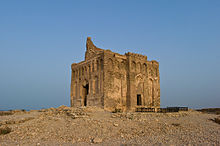Qalhat
| UNESCO World Heritage site | |
|---|---|
 Bibi Maryam mausoleum | |
| Location | Sur Province, Ash Sharqiyah South Governorate, Oman |
| Criteria | Cultural: (ii), (iii) |
| Reference | 1537 |
| Inscription | 2018 (42nd Session) |
| Area | 69.314 ha |
| Buffer zone | 176.1954 ha |
| Coordinates | 22°42′N 59°22′E / 22.700°N 59.367°ECoordinates: 22°42′N 59°22′E / 22.700°N 59.367°E |
The ancient city of Qalhat, or Galhat (Arabic: قلهات) (in the map of Abraham Ortelius, it named as Calha), is located just over 20 km north of Sur, in the Ash Sharqiyah Region of northeastern Oman.
Site description[edit]
During his visit, Ibn Battuta noted that it had "fine bazaars and one of the most beautiful mosques." He further noted the mosque was built by Bibi Maryam and included walls of qashani. Bibi Maryam continued to rule Qalhat and Hurmuz after the death of her husband Ayaz in 1311 or 1312.[1]
Very little remains of the ancient city of Qalhat, save for the now dome-less mausoleum of Bibi Maryam. The city served as an important stop in the wider Indian Ocean trade network, and was also the second city of the Kingdom of Ormus.[2] Covering more than 60 acres (240,000 m2), the ancient city was surrounded by fortified walls that contained houses and shops. Artifacts from as far away as Persia and China were found on-site.[2]
World Heritage Status[edit]
This site was added to the UNESCO World Heritage Tentative List on July 4, 1988 in the Cultural category.[2] The ancient city has become a World Heritage site in 2018.[3]
Qalhat LNG Terminal[edit]
The Oman LNG LLC S.A.O.C. owned Qalhat LNG Terminal is situated at the Port of Qalhat.[4]
References[edit]
- ^ Battutah, Ibn (2002). The Travels of Ibn Battutah. London: Picador. pp. 96–98,308. ISBN 9780330418799.
- ^ a b c The Ancient City of Galhat - UNESCO World Heritage Centre
- ^ "Ancient City of Qalhat". UNESCO.
- ^ Gas Media Releases Archived February 26, 2012, at the Wayback Machine.

